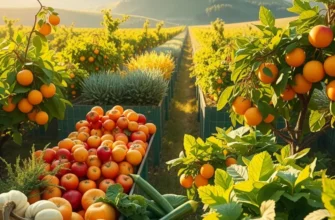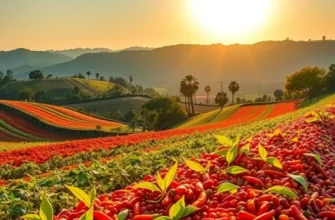Indigenous ingredients are more than just food; they embody culture, history, and identity. Across continents, these native crops, spices, and flavors uniquely reflect the landscapes and traditions of the communities they arise from. As food enthusiasts and culturally-curious consumers dive into global cuisines, understanding and appreciating indigenous ingredients is essential. They not only enhance culinary experiences but also tell stories of resilience and sustainability. This journey unveils the lesser-known yet impactful treasures from around the world, inviting readers to engage with food history and the environments that nurture it.
Roots of Flavor: Uncovering Indigenous Crops

Indigenous crops hold a profound significance in the gastronomic tapestry of human civilization. Their roots are deeply embedded in cultural practices that span across continents and centuries. A notable example is quinoa, hailed as a staple in the Andean regions of South America. Revered by the Incas as “the mother of all grains,” quinoa’s versatility and nutrient-rich profile have helped it remain an integral part of Andean cuisine. Its ability to flourish in harsh mountainous environments exemplifies the harmonious relationship between indigenous crops and their native landscapes.
Across the African continent, cassava stands as a testament to resilience and adaptability. Introduced from the New World, cassava quickly became a cornerstone in African agriculture. Its robust nature allows it to grow in poor soils and drought-prone areas, providing a dependable source of carbohydrates. In many African cuisines, cassava is transformed into a myriad of dishes, from the smooth, starchy fufu to the crispy, fried chips that are ubiquitously enjoyed as street food.
In the lush, tropical climates of Southeast Asia, taro emerges as a cherished ingredient. This starchy root has played a crucial role in the culinary traditions of countries such as the Philippines and Vietnam. Taro’s versatility is showcased in dishes like the Filipino “ginataang halo-halo,” a comforting sweet porridge, and Vietnamese taro spring rolls, which highlight the tuber’s distinct, nutty flavor.
These crops are not only central to their respective cuisines but also symbolize resilience and sustainability. They thrive in environments where other crops might falter, thereby preserving biodiversity and promoting ecological balance. Farmers have long understood that these indigenous plants contribute to a sustainable agricultural system, as they often require fewer resources and help improve soil health.
Such crops also bring a depth of flavor and texture that transforms ordinary dishes into extraordinary culinary experiences. Quinoa’s delicate, nutty taste complements vibrant salads and hearty stews alike, while cassava’s mild flavor allows it to seamlessly blend into both savory and sweet recipes. Taro, with its subtle sweetness and creamy texture, elevates any dish with its unique sensory profile.
The power of these indigenous crops extends beyond their nutritional value; they are cultural icons that underscore the importance of food sovereignty and heritage. By cultivating these plants, communities not only maintain a tangible connection to their past but also lay the foundation for future generations.
The use of indigenous ingredients is not merely a nod to tradition but a step towards a more sustainable food future. Their diversity and resilience can inspire modern culinary practices, encouraging a shift towards ingredients that honor the balance between human needs and environmental stewardship. For more insights into how traditional crops influence modern culinary techniques, explore this exploration of global culinary influences.
Spices and Secrets: The Flavorful Heritage of Indigenous Ingredients

Spices are the soul of culinary traditions, shaping regional flavors and cultural identities across the globe. Indigenous spices, often steeped in tradition and history, offer more than just flavor; they carry stories of connection and community.
Sumac, a tart and tangy spice, is integral to Middle Eastern cuisine. This vibrant spice comes from the dried and ground berries of the sumac bush. Known for its deep red color and citrus undertone, it is a staple in spice blends like za’atar. Sumac adds a unique brightness to dishes such as fattoush, a Lebanese salad, and it is essential in flavoring kebabs and grilled meats. Beyond its flavor, sumac’s importance lies in its ability to enhance community gatherings, where meals are moments of sharing and cultural expression.
In Mexico, chilies are ubiquitous and a culinary treasure. From the fiery habanero to the smoky ancho, chilies provide depth and complexity to Mexican dishes. Native to the region, they are central to traditional moles, salsas, and adobos. Chilies are not merely a taste sensation; they symbolize resilience and adaptation, reflecting the indigenous peoples’ ability to cultivate and utilize nature’s offerings effectively. Chilies play a part in rituals and festivals, underscoring their role in cultural identity.
India’s pepper, often called the “king of spices,” originates from the Malabar coast. Black pepper is a powerful spice used in both traditional and contemporary dishes. Its pungent heat is perfect for seasoning curries and biryanis. Historically, pepper was a prestigious commodity, driving trade routes and cultural exchanges. Its influence on global cuisine is profound, highlighting India’s pivotal role in the spice trade and its vast cultural tapestry.
These indigenous spices forge connections within communities and across continents. They not only elevate local dishes but have also traveled beyond borders, enriching global cuisine. Spices like sumac, chilies, and pepper are flavorful reminders of our interconnected world and the shared culinary heritage we all partake in.
For those looking to incorporate these spices into modern cooking, they’re a natural fit for enhancing dishes without relying on salt, as highlighted in this guide to flavor boosters. Embracing indigenous ingredients allows us to celebrate diversity on our plates, connecting us to the vibrant cultures from which they originate and keeping alive the secrets and stories they carry.
Final words
Indigenous ingredients are not just components of dishes; they encapsulate entire histories, traditions, and ecosystems. As we delve into different cultural practices surrounding these ingredients, we find that they are intimately connected to identity and sustainability. By celebrating these flavors and promoting their use, we honor the communities that have cultivated them for centuries. Embracing indigenous ingredients in our kitchens opens doors to vibrant storytelling, ethical sourcing, and ecological mindfulness. In a world where culinary innovation meets cultural heritage, every bite becomes a meaningful journey.








